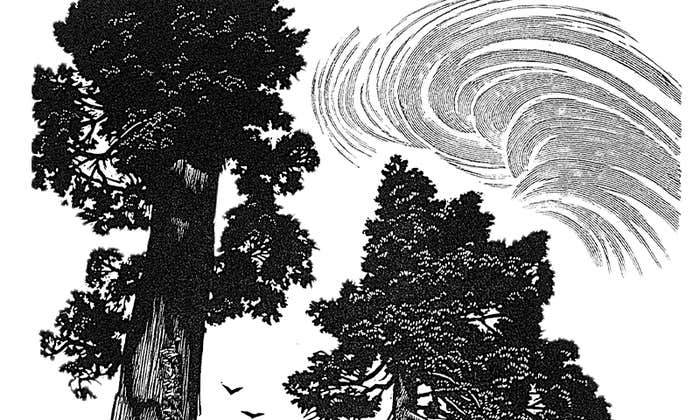Julia Christensen is composing a really long song. It’s a song about the planet and the cosmos that will, ideally, play for two centuries, at least. The song will be sung, in a manner of speaking, by a tiny spacecraft and a series of trees here on Earth.
In some playful sense, the trees and the spacecraft are meant to compose the music together, in a kind of cosmic duet. Christensen and her team will collect data about the spacecraft’s operations and the trees—via sensors that monitor their health—and translate this data into musical notes. Then they’ll use radio signals to send the Earth melodies up to the spacecraft and the space melodies down to the trees. As new data continues to feed into this translation, the song will grow and evolve over time.
How do we design a science project that is meant to collect data for centuries?
When Christensen, an electronic musician and Oberlin professor, first proposed to her NASA collaborators that they try to build a spacecraft that would last 200 years, they told her it was impossible. Spacecraft are designed for specific missions, they said, which tend to last six months, a year, maybe three years at most. If a spacecraft lasts longer, it’s just a happy accident. But the artist wanted to push back against the culture of short-termism in technology design, so she asked the engineers to make longevity itself the mission. This reframe gave the engineers some ideas, she says.
The project, called Tree of Life, took inspiration from The Golden Record, launched with the Voyager mission in 1977. That record contained a sampling of human music from around the world and across time selected by Carl Sagan and collaborators. But rather than put humans at the center of the song, and collect a record of the past, Christensen and her team wanted to create something new and shift the focus from humans to trees. “We wanted to tell a story about life on Earth from a more holistic, ecological perspective,” she says.
Some of the data Christensen and her collaborators have collected from trees has already been sonified. You can listen to the trees “sing” here:
What is the simplest way to describe the Tree of Life Project?
The Tree of Life is a global public art and science initiative. We’re harnessing living trees on Earth to act as antennas that transmit and receive sonic signals with a small spacecraft that we’ve designed. The point is to kind of push the boundaries of obsolescence by ensuring that the project lasts for at least 200 years. We are working to create a story about longevity in relation to science, technology, and culture.
What do you mean by longevity?
Our group is called the Space Song Foundation, and we feel that public imagination, design principles, and the way that we think about science have been shrunk into tiny timeframes. So how do we design a science project that is meant to collect data for centuries? How do we design technology that can actually help support scientific exploration for that long? Technology, especially ubiquitous things like iPhones and personal computers, is designed and built for planned obsolescence. If we are designing technology outside of that paradigm, where the sole purpose is for it to last for 200 years, we probably can do it, actually.
We hope that knowledge and cultural story can make it into design circles so that people do start to think more long-term about the technology that they design. Eventually, we also hope to be able to send an interstellar probe to the planet Proxima Centauri b, the closest interstellar neighbor, 4.2 light-years away, that we think could potentially support life. Even at a tenth of the speed of light, a spacecraft would take 42 years to arrive there. And then it would take more than four years for that data to get back to us on Earth. So how do we plan now to design a spacecraft that might leave Earth in 20 years, take over 40 years to reach its destination, and then take another four years to get data back to us?
Will the sonified data sound like actual music?
We’re actually putting an album out in September. I have this history in electronic music, so I compare it to composers like Maryanne Amacher and Pauline Oliveros. It’s erratic, but also you begin to detect sonic patterns, so it almost becomes rhythmic. Our version of it is pretty experimental, but we’re also designing an online interface that will allow the public to mess with the sound on their own. So as the data comes in, they can play with the interface to change the sonic parameters and basically make the song sound like whatever they want it to.
Over the course of decades and centuries, we want the song and the raw data to be accessible publicly. These long-term data sets should be very valuable to the scientific community. They also say that with the sonification of the data, sometimes you can hear shifts in light or temperature that you wouldn’t necessarily notice if you were just looking at the raw data.
You have said there’s a place where science and art meet on the plane of existential questions. What existential questions drive this work?
It all comes down to who are we and why are we here? How long have we got? And is anybody else out there? My colleagues who are scientists and engineers are very invested in these questions, too. ![]()
Lead image: alexRem / Shutterstock






























